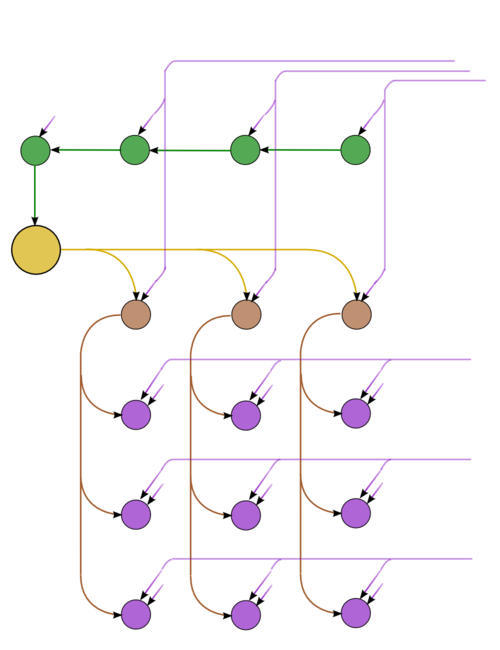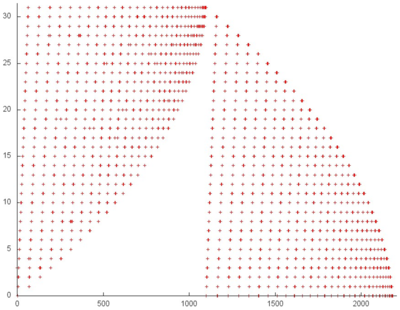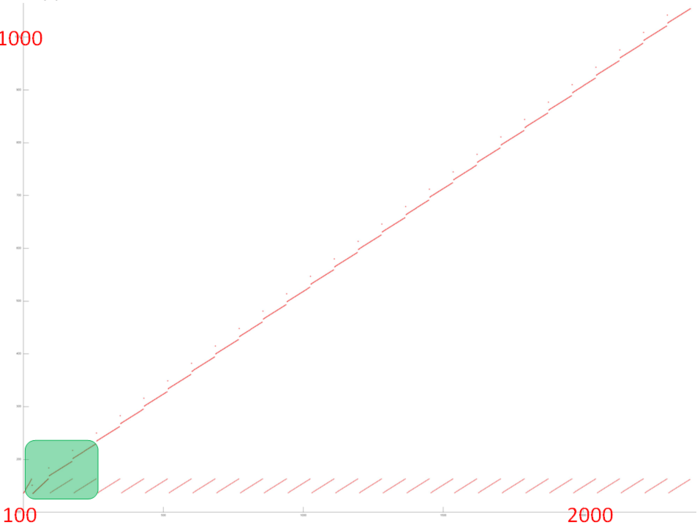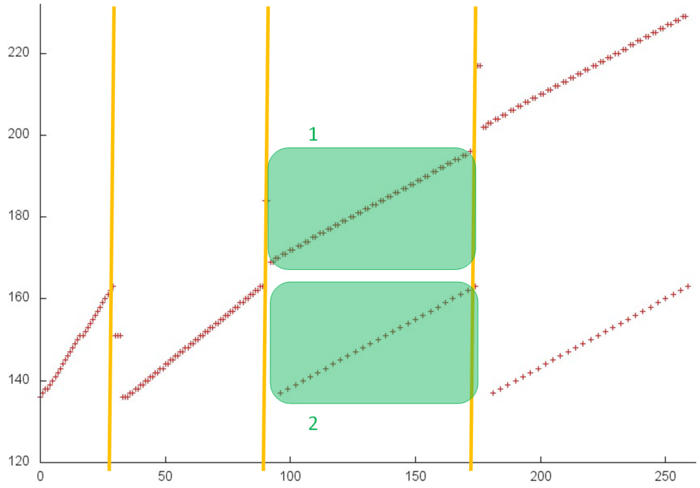Difference between revisions of "Linpack benchmark"
| [unchecked revision] | [unchecked revision] |
| Line 60: | Line 60: | ||
=== Parallelization resource of the algorithm === | === Parallelization resource of the algorithm === | ||
| − | The analysis of parallelization resource of the algorithm shows that | + | The analysis of parallelization resource of the algorithm shows that Gaussian elimination with column pivoting has the highest, namely, ''quadratic'' complexity (exactly because of the pivoting). The other parts of the algorithm have at most linear complexity. Therefore, to optimize calculations, the virtual researcher must optimize Gaussian elimination with column pivoting. Besides, the first fragment of the second part (that is, the solution of the first triangular SLAE) can be attached to the first part and executed almost entirely in the background of the latter. Indeed, both have the same direction of recalculating the data. However, the rest of the second part, despite its similarity to the first fragment, can only be executed on completion the latter. The reason is that these two fragments have opposite directions of recalculating the data. |
=== Input and output data of the algorithm === | === Input and output data of the algorithm === | ||
Revision as of 10:09, 31 October 2017
Primary authors of this description: A.V.Frolov, Vad.V.Voevodin (Section 2.2), A.M.Teplov (раздел Section 2.4)
Contents
- 1 Properties and structure of the algorithm
- 1.1 General description of the algorithm
- 1.2 Mathematical description of the algorithm
- 1.3 Computational kernel of the algorithm
- 1.4 Macro structure of the algorithm
- 1.5 Implementation scheme of the serial algorithm
- 1.6 Serial complexity of the algorithm
- 1.7 Information graph
- 1.8 Parallelization resource of the algorithm
- 1.9 Input and output data of the algorithm
- 1.10 Properties of the algorithm
- 2 Software implementation of the algorithm
- 2.1 Implementation peculiarities of the serial algorithm
- 2.2 Locality of data and computations
- 2.3 Possible methods and considerations for parallel implementation of the algorithm
- 2.4 Scalability of the algorithm and its implementations
- 2.5 Dynamic characteristics and efficiency of the algorithm implementation
- 2.6 Conclusions for different classes of computer architecture
- 2.7 Existing implementations of the algorithm
- 3 References
1 Properties and structure of the algorithm
1.1 General description of the algorithm
Linpack benchmark is a test developed as a supplement to the Linpack library for testing the performance of computer systems. Actually, this test generates a system of linear algebraic equations (SLAE) [math]A \vec{x} = \vec{b}[/math] with a random dense square matrix [math]A[/math] and a vector [math]\vec{b}[/math] chosen so that the solution of the system is the vector [math]\vec{x}[/math] all of whose components are ones; then this SLAE is solved. In view of the general (with certain provisos) nature of the matrix, the solution of the system is divided into several stages. First, the [math]PLU[/math]-decomposition of [math]A[/math] is calculated by using Gaussian elimination with column pivoting ([math]P[/math] is a permutation matrix, [math]L[/math] is a lower triangular matrix with unit diagonal, and [math]U[/math] is an upper triangular matrix). At the second stage, the calculated decomposition is used to solve the SLAE [math]P L U \vec{x} = \vec{b}[/math]. At the third stage, the residual [math]\vec{r} = A \vec{x} - \vec{b}[/math] and the related characteristics are calculated. Then the data concerning the resulting accuracy and performance are produced. The performance is only estimated for the main part of the algorithm; that is, the calculations spent on the residual and norms are ignored.
The Linpack benchmark, which was developed for testing computers of traditional architecture, should not be confused with High Performance Linpack benchmark. The latter was devised for testing parallel computer systems and is based on a different (albeit similar) algorithm.
1.2 Mathematical description of the algorithm
Input data: square matrix [math]A[/math] (with entries [math]a_{ij}[/math]) (in 1992 version, the random number generator is chosen so that to ensure the non-singularity of [math]A[/math]), the right-hand side vector [math]\vec{b}[/math] (with components [math]b_i[/math]). Actually, they are not exactly input data (because the entries of the matrix are pseudo-random numbers generated by the program itself; these numbers are contained in the interval (-1/2, +1/2), and the right-hand sides are calculated as [math]b_i = \sum\limits_{j = 1}^i a_{ij}[/math]). However, in order to analyze the general scheme of the algorithm, it is convenient to regard [math]A[/math] and [math]\vec{b}[/math] as the input data.
Data to be calculated: lower triangular matrix [math]L[/math] (with entries [math]l_{ij}[/math]), upper triangular matrix [math]U[/math] (with entries [math]u_{ij}[/math]), permutation matrix [math]P[/math] (which is calculated as a collection of pivot indices rather than a full square array), and the solution vector [math]x[/math] (with components [math]x_i[/math]).
Here, we do not give detailed formulas of individual parts of the algorithm. These parts are independent algorithms, and their detailed descriptions should be presented separately. Consequently, we only discuss the general scheme of the algorithm.
The first part — decomposing the matrix into the product of two triangular matrices and a permutation matrix: [math]A = P L U[/math] — is performed by using Gaussian elimination with column pivoting. The permutation matrix is stored as a vector containing information on the performed permutations. The matrix [math]L[/math] is lower triangular with unit diagonal, while [math]U[/math] is an upper triangular matrix.
The second part is solving two triangular SLAEs. First, the system [math]L \vec{y} = P T \vec{b}[/math] is solved by forward substitution, then back substitution is used to solve the system [math]U \vec{x} = \vec{y}[/math]. This test stores both triangular matrices in the corresponding portions of the matrix [math]A[/math]. For this reason, [math]A[/math] is generated again (with the same starting parameters for the random number generator) before passing to the third part.
The third part (for which the performance is not measured) calculates first the residual of the solution [math]\vec{r} = A \vec{x} - \vec{b}[/math] and then its uniform norm, as well as the norm of the solution. On the completion of this stage, the algorithm outputs data related to the accuracy of the calculated solution and evaluates the performance of the system.
1.3 Computational kernel of the algorithm
The main part of the algorithm, which is the decomposition of a matrix via Gaussian elimination with column pivoting, is responsible for the bulk of operations. The second most important part is the calculation of the residual and its norm. It is implemented by the subroutine that calculates the sum of a vector and a matrix-vector product and by the function calculating the uniform norm. Less important parts are forward substitution in the Gauss method and back substitution in this method.
1.4 Macro structure of the algorithm
As already said in the description of the computational kernel of the algorithm, the decomposition of a matrix via Gaussian elimination with column pivoting is responsible for the bulk of operations. This decomposition is the first macro operation. It is followed by the forward substitution and, right away, by the back substitution. On the regeneration of the matrix, the next macro operation is calculating the residual for the solution of the SLAE, followed by the calculation the uniform norms of the residual and the solution.
1.5 Implementation scheme of the serial algorithm
The mathematical description of the algorithm was given above. The standard test calculates the triangular decomposition in-place, and the solutions to the triangular systems in the forward and back substitution are written to the locations of the right-hand sides. For this reason, on the calculation of the solution, the coefficient matrix and the right-hand side are regenerated for the subsequent calculation of the residual. As soon as the residual is calculated, its norm and the norm of the solution can be calculated in any order, which does not affect the algorithm and its results.
1.6 Serial complexity of the algorithm
Since the main part of the algorithm is the decomposition of a matrix via Gaussian elimination with column pivoting, the algorithm, as well as this decomposition, has cubical complexity. Other parts have quadratic complexity; consequently, they do not give a comparable contribution to the overall complexity of the algorithm.
1.7 Information graph
The graph consists of the information graphs of its basic parts. The first part (Gaussian elimination with column pivoting) has the most complex graph. Figure 1 shows the simplified graph of this part, post factum the choice of pivots. The operations of finding the maxima in the columns and saving the corresponding positions are given in green. The inversion of the current pivot, multiplications in the current column, and operations of the type [math]a b + c[/math] in the other columns are depicted in yellow, brown, and purple, respectively. Figure 2 shows the graph of a layer (one step of the method). The notation is the same as in the full graph. Dotted lines denote data communication from the pivot row.
The second part consists of almost identical fragments. The first fragment describes the forward substitution, namely, the solution of the SLAE with a lower triangular matrix [math]L \vec{y} = \vec{b}[/math] (Fig.3). The diagonal entries of this matrix are ones; consequently, this fragment contains no divisions. All the green nodes correspond to the operations of the type [math]a b + c[/math]. The second fragment describes the back substitution, namely, the solution of the SLAE with an upper triangular matrix [math]U \vec{x} = \vec{y}[/math] (Fig.4). This matrix has no specific features; hence, the associated graph contains division operations, which are shown in yellow.
1.8 Parallelization resource of the algorithm
The analysis of parallelization resource of the algorithm shows that Gaussian elimination with column pivoting has the highest, namely, quadratic complexity (exactly because of the pivoting). The other parts of the algorithm have at most linear complexity. Therefore, to optimize calculations, the virtual researcher must optimize Gaussian elimination with column pivoting. Besides, the first fragment of the second part (that is, the solution of the first triangular SLAE) can be attached to the first part and executed almost entirely in the background of the latter. Indeed, both have the same direction of recalculating the data. However, the rest of the second part, despite its similarity to the first fragment, can only be executed on completion the latter. The reason is that these two fragments have opposite directions of recalculating the data.
1.9 Input and output data of the algorithm
По сути теста у него всегда одни и те же данные, причём вычисляемые в самом же тесте. Поэтому в строгом смысле у алгоритма нет входных данных.
Выходными данными являются вычисляемые и выдаваемые тестом нормы невязки, решения, матрицы и их отношения, а также вычисляемая мощность вычислений целевой вычислительной системы.
1.10 Properties of the algorithm
2 Software implementation of the algorithm
2.1 Implementation peculiarities of the serial algorithm
Строго говоря, при реализации теста испытывающий компьютерную систему испытывает и версии Линпака или другого пакета, откуда он должен вставлять вызовы разложения Гаусса и решения СЛАУ с помощью полученного разложения. Поэтому находящиеся в сети версии теста не являются догмой, поскольку с их помощью можно тестировать и другие версии реализации метода Гаусса. Как уже отмечено выше, из-за того, что разложение Гаусса вычисляется на месте исходной матрицы, а также из-за того, что при прямом-обратном и обратном ходе решение занимает место правой части, после вычисления решения приходится заново перевычислять как матрицу системы, так и правую часть — для последующего вычисления невязки. Это решение вполне можно поменять с целью оптимизации теста.
2.2 Locality of data and computations
2.2.1 Locality of implementation
2.2.1.1 Structure of memory access and a qualitative estimation of locality
На рис.5 представлен общий профиль обращений в память для теста Linpack. В данном тесте задействовано 3 массива. Обращения к первым двум выделены на рис.5 зеленым цветом (фрагменты 1 и 2), остальные обращения выполняются к элементам третьего массива – матрицы, содержащей коэффициенты СЛАУ. Данный тест состоит из двух этапов – факторизации матрицы и собственно решения СЛАУ. Разделение между этапами отмечено на рисунке оранжевой линией. Видно, что первый этап обладает итерационной структурой, при этом на каждой следующей итерации отбрасываются из рассмотрения несколько элементов матрицы с наименьшими индексами. Также можно заметить, что на втором этапе выполняется два прохода по элементам матрицы с возрастающим шагом, сначала последовательный, затем обратный. Однако в целом профиль устроен достаточно сложно, и для понимания свойств локальности необходимо детальное рассмотрение.
Фрагмент 1 показан отдельно на рис.6. При подобном приближении хорошо видно, что данный фрагмент состоит из двух последовательных переборов всех элементов массива, при этом размер фрагмент очень мал по сравнению с общим профилем. Такой последовательный перебор характеризуется высокой пространственной и достаточно низкой временной локальностью, поскольку к каждому элементу обращение выполняется всего дважды.
Далее перейдем к рассмотрению фрагмента 2, представленного на рис.7. Данный профиль состоит из двух похожих этапов, состоящих из набора итераций. На каждой итерации выполняется последовательный перебор элементов массива, при этом на следующей итерации отбрасывается их рассмотрения один из элементов: на первом этапе – элемент с минимальным индексом, на втором – с максимальным индексом.
Подобный профиль обладает очень высокой как пространственной, так и временной локальностью, поскольку почти всегда обращения выполняются к соседним элементам, причем элементы достаточно часто используются повторно. Однако заметим, что данный фрагмент состоит всего из около 2000 элементов, что значительно меньше общего числа обращений в программе. Значит, большая часть (и, скорее всего, основное влияние) приходится на последний массив.
На рис.8 представлен фрагмент 3, выделенный на рис.5, соответствующий одной итерации цикла, в котором выполняются обращения к данному массиву. Из данного рисунка хорошо видно, что итерация состоит из двух частей, соответствующих двум внутренним циклам. В обоих случаях число обращений на любой итерации внутреннего цикла примерно равно, однако в первом внутреннем цикле на следующей итерации перебирается следующая часть элементов массива, в то время как во втором цикле перебираются одни и те же элементы.
Остается выяснить структуру обращений в память на итерациях данных двух циклов. Рассмотрим более подробно часть фрагмента, выделенную на рис.8 зеленым (рис.9).
Видно, что первые два этапа отличаются от остальных – на них выполняются некоторые начальные действия. Затем начинаются подобные итерации внутренних циклов, причем в обоих случаях (выделенные зеленым части 1 и 2) выполняется последовательный перебор элементов. Основная разница заключается лишь в том, что в первом цикле обращения к каждому элементу выполняются дважды.
Обращения к данному массиву в рамках внутренних циклов характеризуются высокой пространственной локальностью. При этом во втором цикле используются одни и те же элементы, что приводит также и к достаточно высокой временной локальности. Таким образом, в рамках одной итерации (рис. 4) локальность обращений высока. А при условии, что на разных итерациях происходят обращения к одним и тем же элементам (и число обращений на каждой итерации не так уж велико), это приводит к дальнейшему повышению локальности.
2.2.1.2 Quantitative estimation of locality
Основной фрагмент реализации, на основе которого были получены количественные оценки, приведен здесь (оригинал исходного кода взят отсюда). Условия запуска описаны здесь.
Первая оценка выполняется на основе характеристики daps, которая оценивает число выполненных обращений (чтений и записей) в память в секунду. Данная характеристика является аналогом оценки flops применительно к работе с памятью и является в большей степени оценкой производительности взаимодействия с памятью, чем оценкой локальности. Однако она служит хорошим источником информации, в том числе для сравнения с результатами по следующей характеристике cvg.
На рис.10 приведены значения daps для реализаций распространенных алгоритмов, отсортированные по возрастанию (чем больше daps, тем в общем случае выше производительность). Можно увидеть, что данный показатель у теста Linpack один из самых высоких, что говорит об эффективном взаимодействии с памятью.
Вторая характеристика – cvg – предназначена для получения более машинно-независимой оценки локальности. Она определяет, насколько часто в программе необходимо подтягивать данные в кэш-память. Соответственно, чем меньше значение cvg, тем реже это нужно делать, тем лучше локальность.
На рис.11 приведены значения cvg для того же набора реализаций, отсортированные по убыванию (чем меньше cvg, тем в общем случае выше локальность). Можно увидеть, что, согласно данной оценке, локальность обращений в память теста Linpack очень высока, что соответствует полученным ранее оценкам и выводам.
2.3 Possible methods and considerations for parallel implementation of the algorithm
2.4 Scalability of the algorithm and its implementations
2.4.1 Scalability of the algorithm
2.4.2 Scalability of of the algorithm implementation
Проведём исследование масштабируемости реализации HPL теста Linpack согласно методике. Исследование проводилось на суперкомпьютере "Ломоносов" Суперкомпьютерного комплекса Московского университета.
Набор и границы значений изменяемых параметров запуска реализации алгоритма:
- число процессоров [8 : 128] с шагом 8;
- размер матрицы [1000 : 100000] c шагом 1000.
В результате проведённых экспериментов был получен следующий диапазон эффективности реализации алгоритма:
- минимальная эффективность реализации 0.039%;
- максимальная эффективность реализации 86,7%.
На следующих рисунках приведены графики производительности и эффективности теста HPL в зависимости от изменяемых параметров запуска.
Построим оценки масштабируемости теста Linpack:
- По числу процессов: -0.061256. При увеличении числа процессов эффективность на рассмотренной области изменений параметров запуска уменьшается, однако в целом уменьшение не очень быстрое. Малая интенсивность изменения объясняется высокой общей эффективностью работы при больших размерах задачи, однако при росте числа процессов эффективность равномерно уменьшается. Это объясняется также тем, что с ростом вычислительной сложности падение эффективности становится не таким быстрым. Уменьшение эффективности на рассмотренной области работы параллельной программы объясняется быстрым ростом накладных расходов на организацию параллельного выполнения. С ростом вычислительной сложности задачи эффективность снижается так же быстро, но при больших значениях числа процессов. Это подтверждает предположение о том, что накладные расходы начинают сильно превалировать над вычислениями.
- По размеру задачи: 0.010134. При увеличении размера задачи эффективность возрастает. Эффективность возрастает тем быстрее, чем большее число процессов используется для выполнения. Это подтверждает предположение о том, что размер задачи сильно влияет на эффективность выполнения приложения. Оценка показывает, что с ростом размера задачи эффективность на рассмотренной области значений параметров запуска сильно увеличивается. Также, учитывая разницу максимальной и минимальной эффективности почти в 80%, можно сделать вывод, что рост эффективности при увеличении размера задачи наблюдается на большей части рассмотренной области значений.
- По двум направлениям: 0.0000284 При рассмотрении увеличения как вычислительной сложности, так и числа процессов на всей рассмотренной области значений эффективность увеличивается, однако скорость увеличения эффективности не очень большая.
Исследованная реализация теста












